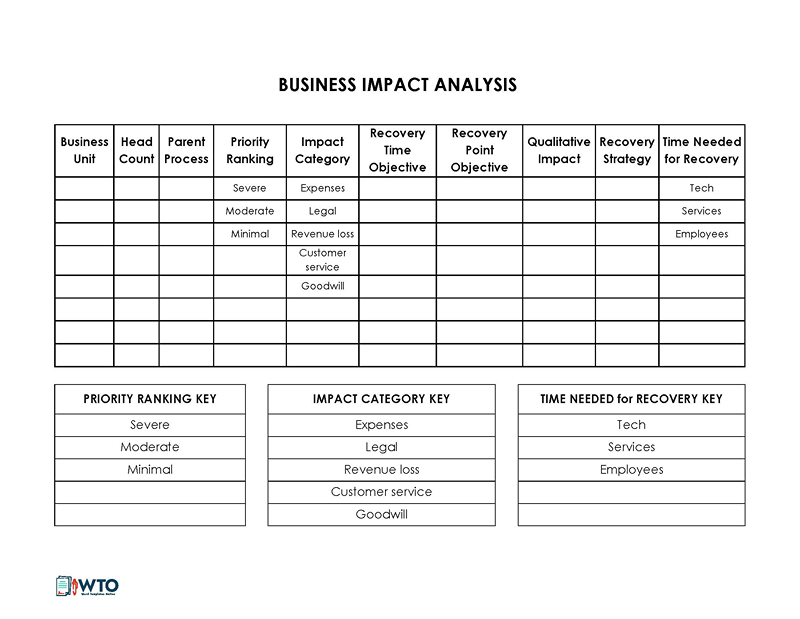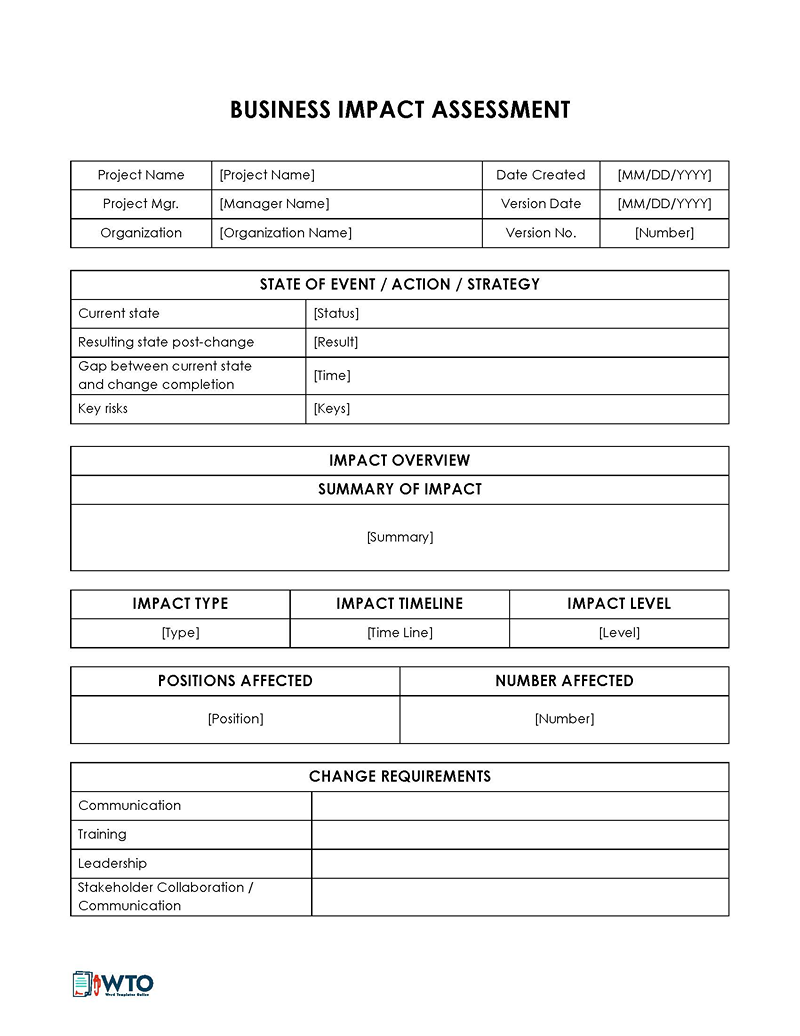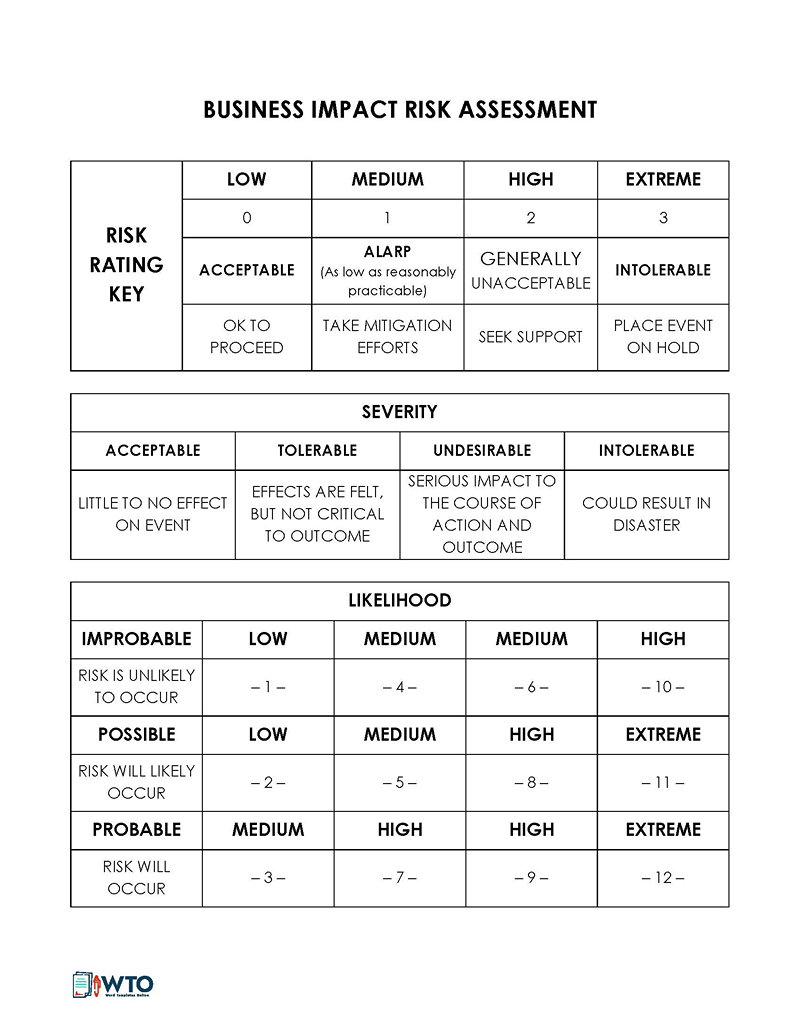An impact analysis is one of the most critical facets of the business continuity management process. This procedure assesses the lasting effect of a change or disruptive event in an organization. The analysis allows an organization to determine how changes may affect its primary operations and overall performance. The implications of such a disruption can include financial, personnel, data, or reputational losses. An organization may also lose its competitive position in a market if the disruption is too severe. It is commonly conducted by project managers, business analysts, software developers, engineers, and third-party consultants.
An impact assessment is usually conducted annually or when an organization reaches a significant milestone or makes a significant change in company operations. For example, offering an IPO (Internal Public Offering), adopting a new budget, tool, process, or technology, launching a new product or service, or the departure of an employee The analysis begins with identifying essential company functions and potential disruptive incidents. The disruption is then analyzed, followed by the development of recovery strategies.
This article will address every aspect of the impact analysis process and provide templates to help you get started with the assessment process. Choose and download one of our templates, then enter values associated with specific incidents such as natural disasters or personnel changes, software interruptions, security breaches, and management or personnel changes.
What is an Impact Analysis Template?
An impact analysis template is a centralized tool that streamlines the assessment process.
It allows you to seamlessly log and review pertinent information to ensure the efficiency of the process. The template, which can be a locally stored or cloud-based spreadsheet, clarifies the data and presents it in a simple yet detailed manner. It contains formulas that quickly calculate metrics such as minimum recovery time, lost revenue, projected budget, and resource allocation. Furthermore, it presents a structured format that makes retrieving the assessment easy when developing strategies to minimize the effects of excessive disruption.
To create the template, you can use MS Excel, a popular spreadsheet program widely used for data analysis and management. It offers a structured method of collecting and evaluating data related to your assessment. With MS Excel, you can modify the template to your requirements since you can add or remove rows or columns, format cells, add images or a logo, and include formulas to automate calculations. It has advanced data analysis features that visualize the information in various ways, including pie charts or line graphs. This can be beneficial if you want to comprehend the implications of the change and make more informed decisions.
Scope of Using a Template for an Impact Analysis
Using a template for the assessment allows you to identify helpful strategies for recovery in the event of a disruption. It presents a structured framework that helps you quantify the potential effects of the change on normal company operations, technology infrastructure, budget, and regulatory compliance. This will assist you and your team in proposing a list of actions that must be taken to resume normal operations.
It also allows you to identify any contractual and regulatory obligations you may have to avoid legal complications. Using a template affirms that all essential constraints associated with an organization’s purpose are met.
Step-by-Step Guide to Increase an Impact Analysis Template’s Value
While it is nearly impossible to avoid change, a template can help mitigate its effect on an organization’s operations. Therefore, the assessment must be executed efficiently to maintain operational continuity after the event.
Below is a step-by-step guide to increasing the template’s value:
Step 1: Identify issues
First, identify the potential issues caused by a disruptive event or change and who or what it may affect. This may include the effect on personnel, business operations, budget, stakeholders, finances, technology infrastructure, or resources. Different organizations have different operating procedures, which is why it is essential to consider every possibility. This will help you establish a framework for minimizing the impact.
Step 2: Identify the risk
Next, identify the risks associated with each issue. Any risk associated with the interruption of operations or loss of resources and personnel should be clearly classified. You should also consider the dependencies involved in the completion of particular objectives.
Step 3: Categorize areas of impact
After that, categorize all the areas that could be affected by each issue. It helps to break each area down into smaller sections for easier assessment. The magnitude of the potential disruption will determine the affected areas. Remember to include pertinent information without going into too much detail.
Departments affected
List the departments within the organization that may be affected by the disruption. For example, the quality assurance department may be affected if new safety standards are issued. Identifying affected departments allows you to allocate resources to a specific department when developing strategies to continue operations.
Jobs/positions/roles affected
Identify the particular jobs within the organization that may be affected by the change. For example, the production team may be affected if there is a scarcity of raw materials. Listing these roles will allow you to allocate more personnel to a specific area when normal operations resume.
Classification of the issue
Categorize the issue by the specific business operation that will be affected by the disruption. For example, if the disruption is linked to purchases, you may categorize it as a procurement issue. This classification will allow you to focus more on a particular area when resuming operations.
Step 4: Prioritize the impact
After categorizing areas of impact in sufficient detail, the next step is to prioritize them by considering various metrics. This will help increase the template’s value for the analysis process. Moreover, it will help you assess the magnitude of each issue and aid you in the development of recovery strategies.
Prioritize issues according to:
Frequency
This entails how often the impact occurs. For example, if it occurs intermittently, it will need to be addressed immediately, as opposed to one that happens once or twice every three months.
Criticality
This pertains to the magnitude to which the impact jeopardizes the success of an organization or project. This will allow you to isolate the main areas of the organization that are critical to its survival.
Complexity
This refers to how challenging each item is to address. Challenging issues may require you to devote more resources and personnel to managing them, thus requiring immediate attention. Less challenging items can be addressed later since they require less attention.
Time involved
This entails how long it will take to address each impact. It should be handled immediately if something requires more time to be addressed. Those that are not time-consuming may be addressed later.
The number of business areas affected
This pertains to the departments and operations within an organization that are affected. If several departments are affected, it should take precedence over an impact that only affects one department or business area.
Position impacted
The position refers to the level or seniority of the person affected by the impact. Issues affecting key policymakers and senior management should be addressed immediately, compared to those affecting lower-level staff.
Difficulty of implementation
This refers to the complexity of enforcing strategies to mitigate the effects of the impact. Compared to less challenging strategies, techniques that are more challenging to implement should be executed first. Ensure you constantly review and update the template to guarantee its efficacy in mitigating potential such items.
Step 5: Develop a strategy
Based on the available information and resources, develop a practical strategy. Your strategy should prioritize operations that have been severely affected, followed by steps that will restore your organization or project to regular or near-normal operation. Include specific columns in the template for actions, budget for implementation, timelines for particular deliverables, and staff responsible for each action. Coming up with these strategies might be challenging, and as such, you should also consider the potential effects of each strategy, both negative and positive, if implemented.
Adhering to the steps outlined above to draft your template can add value to the analysis and guarantee that the potential disruptive event is fully understood. This will help you during the development of mitigation strategies that will effectively manage the impact.
note
The process outlined above may seem tedious, especially if you are assessing more than one project or organization. To help you, download one of our free customizable templates to give your analysis report a professional look. They can be used for various situations and are easily customizable to fit your specific preferences. Using a template helps you save time, allowing you to devote time to implementing recovery strategies.
Types of Impact Analysis Templates
There are different types of templates for effectively executing an impact analysis. Each type has specific tools for evaluating a disruptive event in order to develop recovery strategies.
They include:
Business impact analysis template
This template can help companies develop a proper action plan following a disruption in usual business procedures. It allows for qualitative and quantitative analysis of variables to formulate a personalized recovery strategy to ensure the continuity of operations and maintain productivity. This template can also help a business keep important stakeholders updated on any developments, as well as key points of contact affected.
Change impact assessment template
An organization can use this template to assess changes arising from an impact. It helps identify the effects of the change in terms of the procedures, budget, structures, and personnel that will be affected. It can be used with a management plan to supplement information and aid in the development of recovery strategies.
Privacy impact assessment template
This template can be used by technology and software firms to detect and contain data breaches, malware attacks, viruses, privacy violations, and ransomware attacks. It includes columns for entering personal information, the type of impact, existing safety protocols, and the consequences of data loss. This template can help a firm recover lost data and implement tighter safety measures to ensure minimal impact.
Free Templates
Given below are free templates:




Best Practices for Conducting Impact Analysis
Many organizations do not conduct an impact analysis regularly, and when they do, they do not consider every detail. This is why many projects fail, since unexpected situations can have significant implications.
The following practices can help you ensure you conduct a successful assessment:
Establish clear communication channels
Establish proper communication channels to keep all staff, stakeholders, and teams on the same page. Ensure that the project and suggested solutions are clearly defined. Ensure each team member is adequately informed of what is being proposed and the challenges it intends to solve. This will establish credibility and guarantee the success of the proposed strategies.
Develop a comprehensive plan
Develop a robust plan that will help ensure the process is conducted seamlessly. It should include the scope of the analysis, timeframe, team members involved, key deliverables, and the resources and techniques to be utilized. It should also identify potential risks to your organization’s operations and mitigation strategies.
Document the results
When performing an impact assessment, review your findings before drafting your report. Express your results in charts, diagrams, graphs, and other visual aids to highlight the extent of the effects. Considering the findings, your analysis should provide recommendations for recovery.
Review and update the template
Regularly review and update the template weekly or monthly to ensure it includes current information. You can also present the analysis to senior management to assess, approve, or recommend more reviews on weak areas. This will ensure the assessment process is ongoing and updated, especially when your organization undergoes significant operational changes.
Final Words
An impact analysis is an evaluation technique used by organizations that assesses how an interruption to conventional operations affects various aspects of the organization. This assessment can help you verify and justify changes to the scope of a business or project. The analysis will also help you prioritize recovery areas depending on the undesirable effects on your objectives.
Using a template allows your organization to respond effectively to change, emergencies, or natural disasters. It allows you to input and analyze data pertaining to budget, technology infrastructure, facilities, information systems, and personnel data. The information gathered will guide you in the development of recovery strategies to help achieve your business or project objectives.











